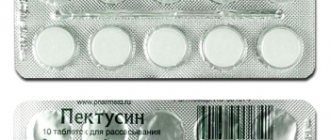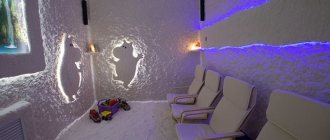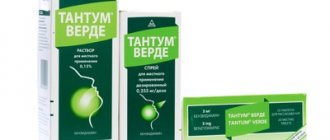general information
"Vibrocil" is a medicine for the treatment of rhinitis of viral and allergic origin. Its formula includes two components:
- phenylephrine (2.5 mg/1 ml) - affects capillaries, leading to their narrowing, period of action - 4-6 hours;
- Dimetindene maleate (250 mcg/1 ml) is a histamine receptor blocker that relieves itching and swelling.
"Vibrocil" is produced in several forms. Children under one year of age are prescribed drops in 15 ml bottles. They look like a yellowish liquid with a lavender scent.
"Nazivin" is a drug used in the treatment of colds. The main substance is oxymetazoline, a vasoconstrictor that lasts longer than 12 hours. In infants, a drop concentration of 0.01% is used (0.1 mg of the active component in 1 ml of medication). They are available in 10 ml bottles. They look like a clear, colorless liquid with a slight odor.
"Vibrocil" and "Nasivin" are sold without a prescription, but in children under one year of age and newborns they should only be used as prescribed by a doctor. It is recommended to store the drops in a dark, cool place.
Price issue
The cost of Vibrocil varies within the following limits:
the price of Vibrocil drops for children varies from 165 to 220 rubles. per bottle of 15 ml; in the form of a spray - from 180 to 300 rubles. for a 15 ml bottle with a spray nozzle; the drug in the form of a gel costs from 180 to 220 rubles. per tube weighing 12 grams.
Otitis media is one of the most common diseases. Only after visiting a doctor can you find out how to treat otitis media in a child.
To learn how to make teething easier for babies, read the following material.
Feeding children is not an easy task. Here you will find delicious and healthy recipes for babies from 9 months.
Features of the action
The instructions indicate that the preparations “Vibrocil” and “Nasivin” contain vasoconstrictor components - phenylephrine and oxymetazoline, respectively. They have a similar effect - they stimulate the receptors of the nasal mucosa, leading to contraction of small blood vessels. As a result:
- swelling of epithelial cells decreases;
- mucus secretion decreases;
- the nasal passages are cleared;
- breathing becomes easier.
The difference between phenylephrine and oxymetazoline is the period of action - the effect of the first lasts 4-6 hours, and the second - 12 hours. Substances with a short duration of action are not typically used in pediatric practice, but phenylephrine is an exception.
Of all the vasoconstrictors, it has the least effect on the cardiovascular system. Treatment of children under one year of age with it is considered relatively safe. Another advantage of phenylephrine is low trauma to the nasal mucosa - it does not reduce the activity of the epithelium.
The second component of Vibrocil drops, dimethindene, has an antiallergic effect: it relieves nasal swelling and reduces the secretion of mucus caused by allergen entering the body.
Young children are very sensitive to various aerosol irritants, and during acute respiratory viral infections this susceptibility increases. The combination of a vasoconstrictor and antihistamine component provides a more pronounced effect for rhinitis.
“Nasivin” also helps children with allergic rhinitis, but only due to its effect on blood vessels, it does not affect histamine receptors. Its advantage is long intervals between instillations.
Reviews
I had a chance to use Vibrocil after I started another renovation of the house with whitewashing the walls and varnishing the parquet floors.
The next morning after such feats, I woke up with terrible nasal congestion, went to the pharmacy, where they recommended this medicine. Three instillations were enough for me to completely return to normal. Anastasia, 27 years old
I suffer from an allergy to poplar fluff. Therefore, during the “season”, every day in the morning before going outside and before going to bed, I use Vibrocil.
For me, this is enough to forget about sneezing attacks, burning sensation and dry mucous membranes. Grigory, 27 years old
In my opinion, it is better to treat children with Vibrocil, since it is rather weak for adults. Oxymetazoline-based products, for example Nazivin, are more suitable for me. They remove swelling better and last longer.
Sergey, 27 years old
The pediatrician prescribed Vibrocil in our nose when my children caught a cold again.
Usually, most of our acute respiratory infections were accompanied by the development of otitis media, sleepless nights because of it, and ultimately the use of antibiotics, but this time everything went away without such complications. Angelina, 27 years old
We tried Vibrocil on the advice of a pediatrician when our 3-month-old son developed a runny nose. The child reacted to the administration of the medicine with loud crying.
I decided to try it on myself, and it was terrible. The nose was broken, but everything inside began to burn and itch. So, these drops are not suitable for us. Pavel, 27 years old
Indications and contraindications
The instructions for the “Nazivin” and “Vibrocil” products inform you that they can be used in children under one year of age and newborns in such cases as:
- acute rhinitis – bacterial, viral and allergic;
- vasomotor rhinitis;
- sinusitis;
- otitis media – to eliminate mucus stagnation in the Eustachian tube;
- preparation for various manipulations in the field of ENT organs;
- Relieving swelling after surgery.
In what cases is a vasoconstrictor drug contraindicated? Basic recommendations:
- general – intolerance to components, atrophic rhinitis;
- “Nazivin” – angle-closure glaucoma;
- "Vibrocil" - during pregnancy, treatment with drugs that suppress monoamine oxidase.
In addition, children with diabetes, hypertension and thyroid dysfunction should take Nazivin drips with caution - according to an individual regimen developed by the doctor.
Another significant point is the choice of concentration of the active substance. In children under one year old, only Vibrocil and Nazivin 0.01% drops can be used. Nasal spray is contraindicated at this age: it can lead to the release of mucus into the Eustachian tube and the development of inflammation.
Similar drugs
Vibrocil has a large number of analogues. Most often, Nazivin in the form of drops is prescribed to children for the treatment of various forms of rhinitis. This medicine has virtually no contraindications or side effects. In addition, Nazivin can be used in children from the first days of life. The duration of action of the drug is 12 hours. Mothers who use Nazivin to treat rhinitis in babies note that the therapeutic effect occurs after the first use. Other analogues of Vibrocil that are effective and safe for children’s health are presented in the table below.
| Name of the drug | Manufacturer country | Release form | Active substance | Age restrictions | Contraindications |
| Adrianol | Yugoslavia | Nasal drops | Phenylephrine and lerimazoline hydrochloride | ≥ 3 years | Hypersensitivity to drug components, hyperthyroidism, pheochromocytoma, glaucoma, acute renal failure, arterial hypertension, ischemia, atrophic rhinitis, atherosclerosis. |
| Rhinopront | Egypt | Syrup | Phenylephrine hydrochloride, carbinoxamine hydrogenmaleate | ≥ 1 year | Hypertension, angle-closure glaucoma, pheochromocytoma, prostate adenoma, hyperthyroidism, arterial hypertension, individual intolerance to the components of the drug. |
| Otrivin | Switzerland | Nasal drops, spray | Oxylometazoline hydrochloride | None | Sensitivity to the components of the drug, arterial hypertension, tachycardia, atherosclerosis, glaucoma, dry or atrophic rhinitis, hyperthyroidism, rehabilitation period after transsphenoidal hypophysectomy, surgery on the meninges. |
| Sanorin | Israel | Nasal drops, spray | Naphazoline nitrate | ≥ 2 years | Chronic rhinitis, angle-closure glaucoma, arterial hypertension, atherosclerosis, tachycardia, hyperthyroidism, diabetes, concomitant use of MAOIs and a two-week period after their discontinuation, hypersensitivity to the components of the drug. |
| Xylene | Russia | Nasal drops, spray | Oxylometazoline hydrochloride | None | Angle-closure glaucoma, atrophic rhinitis, arterial hypertension, tachycardia, atherosclerosis, hyperthyroidism, surgery on the meninges, sensitivity to the active substance. |
Pediatrician, allergist-immunologist, graduated from Samara State Medical University with a degree in Pediatrics. Read more »
How to use?
The instructions contain the following scheme for using Nazivin:
- for newborns (up to 4 weeks) – 1 drop in each stroke;
- up to a year – 1-2 drops.
Regularity – 2-3 times a day.
The dosage of “Vibrocil” for infants is 1 drop in one nostril 3-4 times a day. The duration of therapy for both drugs is no more than 7 days, but it is better when it does not exceed 3-5 days. In this case, the likelihood of addiction is reduced.
Drops in children are used not planned, but symptomatically: if the required time interval has passed and the nose is breathing normally, there is no need to instill them. It is important not to exceed the dosage and frequency of drug administration, otherwise the risk of side effects increases.
Before instilling drugs, the baby's nasal passages must be cleared of mucus with saline solution and an aspirator. Instructions for administering the medicine:
- Lay the baby on his back.
- Turn its head to the right, drip the solution into the right nasal passage, and squeeze it.
- Wait 1-2 minutes and repeat all manipulations with the left nostril.
For the smallest children, you can drip the product onto cotton pads and place them one by one in the nasal passages.
Mode of application
Before administering the drug, you should rinse your nasal passages with any saline solution.
As such, you can choose special systems, for example Aquamaris and Dolphin, or use an affordable, but no less effective saline solution or a homemade solution of table salt and improvised means.
The medicine is administered with the head thrown back. Moreover, this position must be maintained for another 10–15 seconds after administration.
Like all vasoconstrictors, Vibrocil nasal drops should not be used for more than a week. In the opposite case, there is a high risk of addiction, manifested by the constant persistence of swelling until new doses of the medication are administered.
If the patient’s condition does not improve within a week, especially if after temporary relief it has sharply worsened, you should definitely consult a doctor. Perhaps rhinitis is bacterial in nature or can lead to serious complications.
In such situations, the doctor may prescribe an antibiotic. As a rule, preference is given to medications for topical use, for example, Isofra or Polydex.
Side effects
The active ingredients of “Vibrocil” and “Nazivin” are practically not absorbed into the bloodstream and do not have a significant effect on the body. Both remedies can cause a burning and dry feeling in the nose, as well as sneezing. Vibrocil does not cause any other negative reactions in children. The list of side effects of Nazivin is wider:
- tachycardia;
- hypertension;
- sleep disturbance;
- headache;
- nausea.
The instructions inform you that such reactions occur only with prolonged use and overdoses.
A significant overdose of oxymetazoline can lead to dysfunction of the gastrointestinal tract, hyperthermia, abnormal heart rhythm, pulmonary edema, central nervous system depression and even cardiac arrest. Exceeding the norm of phenylephrine is fraught with nausea, vomiting, abdominal pain and rapid heartbeat.
It is not recommended to combine treatment with Vibrocil and Nazivin with taking:
- monoamine oxidase inhibitors;
- tricyclic antidepressants;
- antihypertensive drugs.
Doctor Komarovsky Vibrocil
Vibrocil is a vasoconstrictor. It is recommended to be used to eliminate signs of rhinitis, sinusitis, and otitis media.
Vibrocil is available in several dosage forms: drops, gels, spray.
The therapeutic effect of the drug is explained by phenylephrine and dimethindene.
Vibrocil drops are a clear, colorless or yellowish liquid that smells like lavender.
Phenylephrine eliminates swelling of the nasal mucosa and paranasal sinuses.
Dimetindene relieves allergy symptoms.
Vibrocil drops are prescribed to children if they are diagnosed with:
- acute rhinitis, including those accompanying a cold;
- runny nose of an allergic nature, including hay fever
- acute and chronic inflammation of the paranasal sinus mucosa;
- neurovegetative rhinitis;
- chronic runny nose;
- acute inflammation of the middle ear.
Drops are used to prepare for surgery in the nasal area or to eliminate swelling of the nasal cavity and paranasal sinuses after surgery.
Vibrocil drops should not be instilled into children under one year of age. Spray and gel are allowed from 6 years of age.
The dosage of Vibrocil is selected individually depending on the age of the child:
Age Single dose in drops
| 1-6 years | 1-2 |
| Over 6 years old | 3-4 |
You need to drip 3-4 times a day.
Parents should consider the following:
- Before instilling the medicine Vibrocil, you need to clean your nostrils.
- Tilt the child's head back and instill the drug. You need to keep your head in this position for several minutes.
- Treatment with Vibrocil should not last more than 1 week. If you drip the medicine for a long time, it can cause addiction and a “ricochet” effect, the development of drug-induced rhinitis.
- If the signs of the disease do not go away, then you need to show the child to the doctor.
- To prevent the drops from losing their therapeutic effect, they must be stored at temperatures up to 30 degrees for 36 months.
- Vibrocil is not recommended for use if the child is receiving β-blockers, tricyclics, or tetracyclic antidepressants.
Vibrocil drops should not be given to a child who has been diagnosed with the following pathologies:
- allergy to the composition of the medication;
- angle-closure glaucoma;
- chronic runny nose, which is accompanied by atrophy of the nasal mucosa and the nerve endings located here.
Vibrocil should not be instilled into a child if he is undergoing treatment with MAO inhibitors or if it ended less than 2 weeks ago.
The drug should be administered with caution if the patient is diagnosed with the following pathologies:
- hyperfunction of the thyroid gland;
- diabetes;
- epilepsy;
- narrowing of the bladder neck;
- heart rhythm disturbance, multifocal atherosclerosis, arterial hypertension.
The drug should be administered with caution to a child who has a severe reaction to indirect adrenergic agonists, which is manifested by sleep and heart rhythm disturbances, dizziness, increased blood pressure, trembling of the limbs and other parts of the body.
Vibrocil drops may cause side effects in a child:
- burning, dryness and discomfort in the nose;
- bleeding from the nasal cavity.
If the child’s undesirable effects worsen or reactions appear that are not described in the instructions, you should tell your doctor about them.
If you instill a vasoconstrictor in dosages higher than therapeutic, this can cause an overdose, which is manifested by the following symptoms:
- occipital pain;
- tachycardia;
- paler skin;
- excessive excitement;
- sleep disturbance;
- dizziness;
- nausea, vomiting, pain in the epigastric region;
- extrasystole;
- trembling of individual parts of the body;
- feeling tired;
- increased blood pressure.
For an overdose of Vibrocil, the antidote is unknown. The child is given activated carbon. Young children are prescribed a laxative; patients over 6 years of age are advised to drink plenty of fluids in case of overdose.
To normalize high blood pressure provoked by phenylephrine, alpha-blockers are prescribed.
How much Vibrocil costs depends on the specific pharmacy. The price of drops in Moscow and Yekaterinburg is 309 rubles, St. Petersburg - 298 rubles, Novosibirsk - 266 rubles. The cost of Vibrocil drops can be found on the pharmacy website. RU.
There are no complete analogues of Vibrocil on sale; there are only its substitutes according to the therapeutic group. For a runny nose, doctors prescribe:
Nazivin contains oxymetazoline as its main component. The drug is available in drops and spray.
Both medications have common indications, contraindications, and adverse reactions, but Nazivin is approved for children up to one year old and its effect lasts up to 12 hours, which allows it to be instilled 2 times a day.
It is impossible to say definitively which medication is better, since Nazivin is more suitable for some children, Vibrocil for others.
Rinofluimucil is a combination medication that is available in the form of a nasal spray. The drug eliminates swelling of the nasal mucosa, thins purulent mucous secretions in the nasal cavity, relieves inflammation, and normalizes breathing.
Rinofluimucil is not used for allergic rhinitis and otitis media. It is contraindicated in cases of intolerance to its composition, hyperthyroidism, and angle-closure glaucoma. Rinofluimucil can be used in children of any age, but for children under 3 years of age, it should be prescribed with caution.
Unlike Vibrocil, Rinofluimucil is more likely to cause adverse reactions.
Protargol contains silver proteinate as an active ingredient. The medicine has an antiseptic and anti-inflammatory effect. Protargol prevents bacteria from multiplying on the nasal mucosa. It is used for acute rhinitis and sinusitis.
Protargol is contraindicated in case of atrophic rhinitis, allergies to the composition of the medication. The drug acts directly on the cause of rhinitis and sinusitis, and not just as Vibrocil eliminates the symptoms of the disease. But this does not mean that Protargol is better, since it is ineffective for allergic rhinitis and otitis media.
In addition, silver proteinate can cause allergies, including Quincke's edema.
Snoop is available in a spray, which contains 0.05% and 0.1% xylometazoline as active ingredients. It has the same indications for use as Vibrocil, but Snoop has more contraindications and adverse reactions. It can only be used by children over 2 years old.
Due to treatment, they may experience allergies, headaches, difficulty falling asleep, blurred vision, increased heart rate, increased blood pressure, vomiting, depression, dryness, swelling, burning of the nasal mucosa, and sneezing.
But the effects of Snoop last longer than those of the phenylephrine-based drug.
Polydexa is a combined spray that, in addition to phenylephrine, contains dexamethasone, neomycin, polymyxin B. In addition to the fact that the drug eliminates swelling and normalizes breathing, it also has an antibacterial effect.
Polydexa can be used in patients over 2.5 years of age with rhinitis, nasopharyngitis and sinusitis. The medicine has more contraindications than Vibrocil drops.
But this does not mean that Polydex spray is worse and perhaps it is more suitable for a particular child.
The doctor should select an analogue of Vibrocil, since each medicine has its own characteristics.
There are a lot of positive reviews about Vibrocil drops on the Internet. Parents like the following about the drug:
- drops are possible from one year onwards;
- After instillation of the drug, the effect occurs quickly, and within 5 minutes nasal breathing normalizes.
Among the shortcomings, parents note the following:
- high price;
- the pipette is inconvenient, it doesn’t pick up drops well and you can’t see how much medicine is flowing out;
- presence of contraindications.
Evgeniy Olegovich believes that vasoconstrictors should be in every home medicine cabinet. In his opinion, Vibrocil is optimal for young children.
But it should be used only according to strict indications, when the child has not just a runny nose, but a stuffy nose due to a high temperature or he breathes through his mouth while in a dry and warm room.
He also recommends dripping them into the nose for otitis media to eliminate swelling and pain in the ears.
Despite the fact that vasoconstrictor drops are available without a prescription, they must be prescribed by a doctor who will tell you how much Vibrocil to drip to the child.
Source: https://str-control.ru/preparaty-dlya-lecheniya-nasmorka/doktor-komarovskiy-vibrotsil/







